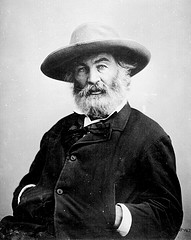
“I saw the book, but I didn’t read it at all — didn’t think it worth reading. Mother thought as I did.” — Walt Whitman’s brother George, on Leaves of Grass

“I saw the book, but I didn’t read it at all — didn’t think it worth reading. Mother thought as I did.” — Walt Whitman’s brother George, on Leaves of Grass
In 1810, the house of a Mr. Chave at Sampford Peverell in southwestern England seemed to be invaded by a violent ghost that hated women.
Charles Colton reported that the women who slept in the house, several of whom he had interviewed under oath, had told that “their night’s rest was invariably destroyed by violent blows from some invisible hand, by an unaccountable and rapid drawing and withdrawing of the curtains, by a suffocating and almost inexpressible weight, and by a repetition of sounds, so loud as at times to shake the whole room.”
Chave and his servants swore they had no hand in it (indeed, the notoriety reduced the value of the house), and a reward of £250 brought no further information. Someone was up to something that spring in Devon, but exactly who, and what, and why, have never been discovered.
I lately lost a preposition;
It hid, I thought, beneath my chair
And angrily I cried, “Perdition!
Up from out of under there.”
Correctness is my vade mecum,
And straggling phrases I abhor,
And yet I wondered, “What should he come
Up from out of under for?”
— Morris Bishop
Here are two envelopes. One contains twice as much money as the other. You must choose one, and then consider whether to keep it or exchange it for mine. Which should you do?
It would seem advantageous to switch: Depending on which envelope you started with, you’ll either lose a little or gain a lot. (If your unopened envelope contains $10, for example, the other must contain $5 or $20.)
So we trade envelopes and I offer you the same deal. But now the same reasoning applies, so it makes sense to trade again. Indeed, it seems reasonable to keep exchanging envelopes forever, without ever opening one. How can this be?
In 1891, Robert Louis Stevenson received a letter from a Vermont girl named Annie Ide. Her birthday fell on Christmas, she said, and she seldom received birthday presents.
He replied with a document decreeing that “I, Robert Louis Stevenson, … in consideration that Miss Annie H. Ide, … was born, out of all reason, upon Christmas Day, and is therefore out of all justice denied the consolation and profit of a proper birthday; and considering that I, the said Robert Louis Stevenson, have attained an age when we never mention it, and that I have now no further use for a birthday of any description; … HAVE TRANSFERRED, and DO HEREBY TRANSFER, to the said Annie H. Ide, ALL AND WHOLE my rights and privileges in the thirteenth day of November, formerly my birthday, now, hereby, and henceforth, the birthday of the said Annie H. Ide, to have, hold, exercise, and enjoy the same in the customary manner, by the sporting of fine raiment, eating of rich meats, and receipt of gifts, compliments, and copies of verse, according to the manner of our ancestors.”
He charged her to add “Louisa” to her name, “at least in private,” and to use the birthday “with moderation and humanity”—and he directed that if she neglected these conditions the birthday would revert to the president of the United States. She didn’t.
The stories illustrating the sagacity of the elephant are innumerable; but few are more remarkable than the following one recorded by a writer in a Bombay paper upon the authority of an artillery officer, who was a witness of the incident:– The battering train was going to the siege of Seringapatam, when an artilleryman, who was seated on the tumbril of one of the guns, by some accident fell almost directly under the hind wheel. The elephant stationed behind the gun, perceiving the man’s danger, instantly, without any order from its keeper, lifted up the wheel with its trunk, and kept it suspended till the carriage had passed clear of him.
— Henry Williams, A Book of Curious Facts, 1903

Bata Kindai Amgoza ibn LoBagola told an inspiring story: Born in West Africa, he wandered to the sea at age 7 and found himself aboard a steamer bound for Scotland. From there he made his way to the United States, where he took up lecturing. His 1930 autobiography, LoBagola; An African Savage’s Own Story, gives vivid details about life in the bush:
“If you should climb a tree, the lion can easily get help from the elephant, because the elephant and the lion are friendly. … [T]he lion tells the elephant that it wants you down from the tree, and the elephant shakes the tree or pulls it up by the roots, and down you come.”
The truth was more prosaic: His real name was Joseph Lee and he was born in Baltimore. “Small opportunities,” wrote Demosthenes, “are often the beginning of great enterprises.”
Visiting a ruined English manor in 1856, Nathaniel Hawthorne felt “haunted and perplexed” by the idea that he had seen it before. He later realized that Alexander Pope had written a poem about it nearly 100 years earlier.
Dick Termes paints murals on spheres. And he does it with a unique “six-point” perspective technique that permits a remarkable optical illusion.
As you watch this video, try to convince yourself that the front half of the sphere is transparent and that the mural is painted on the concave interior of the farther side — that is, that you’re standing in the center of the pictured room and turning in place to your left. If you succeed, the spin will seem to reverse direction and you’ll find yourself inside the painting: